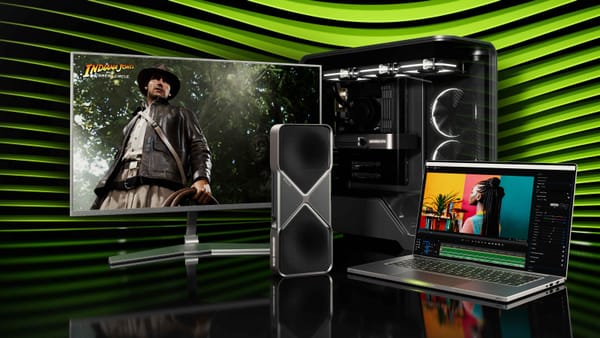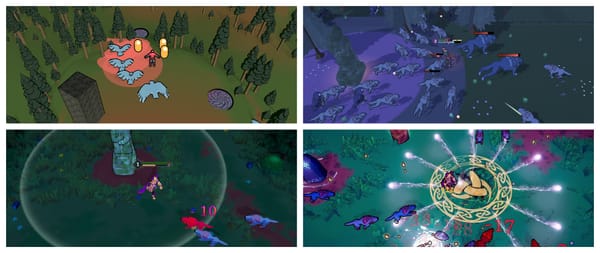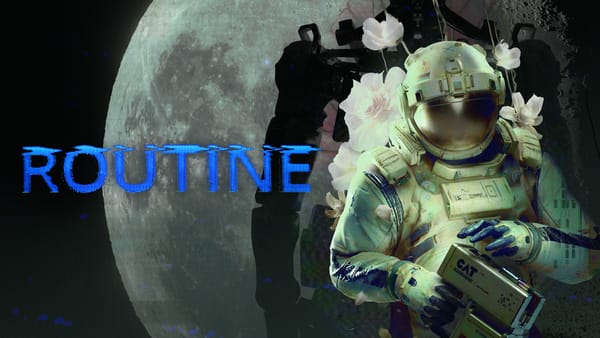Nvidia GeForce RTX 50 Series, DLSS 4, RTX Neural Rendering and More




At CES 2025 in Las Vegas, Nvidia announced the GeForce RTX 50 Series GPUs. DLSS 4 will feature Multi Frame Generation and AI is coming to Shaders. All the reveals at a glance.
Nvidia has unveiled the GeForce RTX 50 Series of desktop and laptop GPUs at CES. The new consumer GPUs for gamers, creators, and developers are powered by the Nvidia Blackwell architecture, fifth-generation Tensor Cores, and fourth-generation RT Cores. "Blackwell, the engine of AI, has arrived for PC gamers, developers and creatives," said Jensen Huang, founder and CEO of Nvidia. "Fusing AI-driven neural rendering and ray tracing, Blackwell is the most significant computer graphics innovation since we introduced programmable shading 25 years ago."
The flagship product, the GeForce RTX 5090 GPU, features 92 billion transistors, providing over 3,352 trillion AI operations per second (TOPS) of computing power. "Thanks to the Blackwell architecture’s innovations and DLSS 4, the GeForce RTX 5090 outperforms the GeForce RTX 4090 by 2X", the company said.
For desktop users, the GeForce RTX 5090 GPU (32 GB GDDR7) with 3,352 AI TOPS and the GeForce RTX 5080 GPU (16 GB GDDR7) with 1,801 AI TOPS will be available on 30 January 2025 for $1,999 (€2,329) and $999 (€1,169) respectively. By way of comparison, the RTX 4090 with 24 GB of VRAM started at €1,949 at launch, while the RTX 4080 sold for €1,469. The RTX 5080 now costs almost €300 less than its predecessor. The GeForce RTX 5070 Ti GPU (16 GB GDDR7) with 1,406 AI TOPS and the GeForce RTX 5070 GPU (12 GB GDDR7) with 988 AI TOPS will be available in February for $749 ( €879) and $549 (€649) repectively.
Nvidia Founders Editions will be available directly from nvidia.com and select retailers worldwide. Stock-clocked and factory overclocked models will be available from add-in card providers including Asus, Colorful, Gainward, Galax, Gigabyte, Inno3D, KFA2, MSI, Palit, Pny, and Zotac, as well as desktop models from system builders including Falcon Northwest, Infiniarc, Maingear, Mifcom, Origin PC, PC Specialist, and Scan Computers. Laptops with GeForce RTX 5090, RTX 5080 and RTX 5070 Ti GPUs will be available in March and RTX 5070 laptop GPUs in April from manufacturers including Acer, Asus, Dell, Gigabyte, HP, Lenovo, Mechrevo, MSI and Razer.
The Blackwell architecture will support all previous DLSS features and introduce Multi Frame Generation, available only in DLSS 4 and exclusive to the Blackwell architecture. Multi Frame Generation is the next evolution of Frame Generation. It increases frame rates by using AI to generate up to three frames per rendered frame. Nvidia claims up to an 8x performance improvement over traditional rendering, while maintaining responsiveness with Nvidia Reflex technology. Speaking of Reflex. Nvidia Reflex 2 introduces Frame Warp, a technique to reduce latency in games by updating a rendered frame based on the last mouse input just before it is sent to the display. According to Nvidia, Reflex 2 can reduce latency by up to 75 per cent.
"DLSS 4 also introduces the graphics industry's first real-time application of the transformer model architecture. Transformer-based DLSS Ray Reconstruction and Super Resolution models use 2x more parameters and 4x more compute to provide greater stability, reduced ghosting, higher details and enhanced anti-aliasing in game scenes," the company said. The core improvements to Ray Reconstruction and Super Resolution are available for every GeForce RTX user too. DLSS 4 will be supported on GeForce RTX 50 Series GPUs in more than 75 games and applications on launch day.
"DLSS 4 also introduces the biggest upgrade to its AI models since the release of DLSS 2.0 in 2020. DLSS Ray Reconstruction, DLSS Super Resolution, and DLAA will now be powered by the graphics industry's first real-time application of 'transformers', the same advanced architecture powering frontier AI models like ChatGPT, Flux, and Gemini. DLSS transformer models improve image quality with improved temporal stability, less ghosting, and higher detail in motion." - Nvidia
Doom: The Dark Ages comes with DLSS Multi Frame Generation, DLSS Ray Reconstruction and Path Tracing. "With DLSS 4, we are stepping into a new era of gaming. The new ray reconstruction transformer model powers a historical leap in raytracing capabilities; not just accelerating performance but also enhancing visuals in DOOM: The Dark Ages," Billy Khan, Director of Engine Technology, id Software. The reveal trailer from The Witcher IV was pre-rendered in Unreal Engine 5 on a GeForce RTX 5090. Black State is also launching with DLSS Multi Frame Generation, Reflex and Ray Tracing. "Nvidia GeForce RTX 50 Series and DLSS 4 are game changing. We now have the power and technologies to realize the future of interactive storytelling with Black State", Kadir Demirden - CEO, Motion Blur. Dune: Awakening will launch with DLSS Multi Frame Generation too. "GeForce RTX 50 Series and DLSS 4 mark the beginning of a new generation of games", said Rui Casais, CEO Funcom.
Indiana Jones and the Great Circle will get DLSS Multi Frame Generation, DLSS Ray Reconstruction and RTX Hair via update. "With GeForce RTX 50 Series, players will be able to experience Indiana Jones and the Great Circle at its best. With elevated image quality, performance, and new neural rendering tech like Nvidia RTX Hair introduces a new level of character realism, truly adding to the immersion of becoming Indy," said Jim Kjellin, CTO of MachineGames. Marvel Rivals, Naraka: Bladepoint and Black Myth: Wukong will also be upgraded to DLSS Multi Frame Generation.
Alan Wake 2 will get DLSS Multi Frame Generation as well and is the first game to feature the new Nvidia RTX Mega Geometry technology. "Available on all GeForce RTX graphics cards and laptops, RTX Mega Geometry intelligently clusters and updates complex geometry for ray tracing calculations in real-time, reducing CPU overhead. This improves FPS, and reduces VRAM consumption in heavy ray-traced scenes." The update for Alan Wake 2 also introduces support for the new transformer-based DLSS model, which improves image quality. "With DLSS 4 and GeForce RTX 50 Series we are seeing significant performance gains which enable us to create new game worlds larger and more detailed than ever," said Mika Vehkala, Chief Technology Officer, Remedy Entertainment.
Blackwell also brings AI to shaders. Alongside the RTX 50 Series GPUs, Nvidia is introducing RTX Neural Shaders, which bring small AI networks to programmable shaders, unlocking film-quality materials, lighting and more in real-time games, according to Nvidia: "RTX Neural Faces takes a simple rasterized face and 3D pose data as input, and uses generative AI to render a temporally stable, high-quality digital face in real time. RTX Neural Faces is complemented by new RTX technologies for ray-traced hair and skin. Along with the new RTX Mega Geometry, which enables up to 100x more ray-traced triangles in a scene, these advancements are poised to deliver a massive leap in realism for game characters and environments."
"Microsoft is excited to partner with Nvidia to catalyze this next generation of graphics programming by bringing industry-wide support for neural shading technology," said Bryan Langley, partner group program manager of Silicon, Media, and Graphics at Microsoft. "DirectX will soon support Cooperative Vectors, which will unlock the power of Tensor Cores on Nvidia GeForce RTX hardware and enable game developers to fully accelerate neural shaders on Windows."
Nvidia is introducing a suite of new ACE technologies that enable game characters to perceive, plan, and act more like human players. ACE-powered autonomous characters will be integrated into Krafton's PUBG: Battlegrounds and InZOI, as well as Wemade Next's MIR5. "Nvidia enables game developers to push past expected boundaries with AI technology. Nvidia Ace in Naraka: Bladepoint Mobile PC Version allows us to create AI autonomous characters that allows us to create AI autonomous teammates running on the device locally that naturally assist the player in their epic battles", Zhipeng Hu, Head of Thunder Fire BU, SVP of NetEase corp.
GeForce Now users will soon be able to play titles from their Steam library with the launch of a native GeForce Now app for the Steam Deck later this year. Previously, GeForce Now could only be used on the Steam Deck via a workaround. In collaboration with Apple, Meta, and ByteDance, Nvidia is extending GeForce Now cloud gaming to Apple Vision Pro, Meta Quest 3 and 3S, and Pico devices. Nvidia is also opening the first GeForce RTX-powered data centre in India, and Doom: The Dark Ages and Avowed will be coming to the cloud when they launch on PC later this year.
In addition, Nvidia will release a pipeline of NIM microservices and AI blueprints for RTX AI PCs from developers such as Black Forest Labs, Meta, Mistral and Stability AI to build AI agents and assistants. "Use cases span LLMs, vision language models, image generation, speech, embedding models for retrieval-augmented generation, PDF extraction and computer vision."
The RTX 50 Series GPUs are the first consumer GPUs to support FP4 precision, boosting AI image generation performance and enabling generative AI models to run locally with a smaller memory footprint compared to previous-generation hardware. The Nvidia Broadcast app gets two AI-powered beta features for livestreamers: Studio Voice, which enhances microphone audio, and Virtual Key Light, which lights up faces for polished streams.








